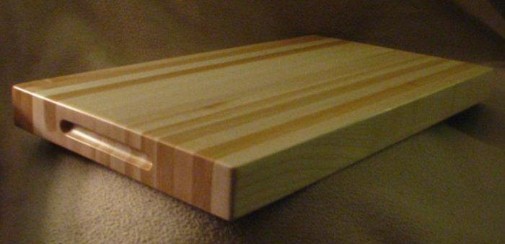Hand made commercial butcher block cutting boards are crafted from hard maple with edge grain construction, reversible board features with a food grade oil finish and carved-in hand grips. Crafted to meet the same standards of professional chefs from around the world, our butcher block cutting boards are a top choice for both professional chefs and the casual cook. Each board will be priced by size and type of wood used. Maple butcher block cutting boards can be accented with Cherry or Walnut. A typical butcher block cutting board will measure 8" x 14" x 1.5" to 12" x 20" x 2-1/4". I can custom make one to your desired size. We also make Walnut, Hickory, Teal, Bamboo and conga butcher blocks. Please call or email for a pricing quote.
The maple tree can be easily identified by it characteristic three to five lobed leaf. It is also well know for it's "helicopter" seeds. I hand build butch block cutting boards with Northern Hard Maple for one very good reason. Northern Hard Maple is the best wood for a butcher block cutting board because of its density, hardness and tight grain structure. The further north a Maple tree grows the more dense or strong it generally becomes.
Your butcher block cutting board will come to you pre-seasoned. Proper surface treatment is important to guard against germs and/or mold growth. The wood surface needs an oil that can be repeatedly applied to fill the wood pores and repel food particles, liquids, and other oils. Never use any vegetable or cooking oils to treat or finish a cutting surface, as in time the wood will reek of a rancid spoiled oil odor.
The general rule of thumb is a new Butcher Block cutting board should be oiled once a day for a week, once a week for a month and once a month forever. All sides of the butcher block cutting board should be liberally coated. Sponge on with a rag! I recommend Watco Butch Block Oil or a good mineral oil.
THE AVERAGE PERSON CAN LENGTHEN THE LIFE OF A BUTCHER BLOCK CUTTING BOARD 5-10 YEARS THROUGH OBSERVING THE FOLLOWING RULES FOR ITS CARE.
1. DO NOT immerse the butcher block cutting board in water. Instead, sponge it off with warm soapy water. If the butcher block cutting board needs to be disinfected, a 1 part bleach to 10 parts water can be used or vinegar. I recommend the use of vinegar as the acetic acid in the vinegar is a good disinfectant, effective against such harmful bugs as E. coli, Salmonella, and Staphylococcus. Vinegar is especially good for people with chemical allergies. Dry it thoroughly. Never store it flat (no air flow) or near a high heat source. For better food safety, sanitize your washed butcher block cutting board after using with raw meat, poultry, and seafood. Prep your RAW vegetables first, and then flip it over to prep your meats. This should minimize cross-contamination.
2. DO NOT prop a wet butcher block cutting board up and allow the water to sheet off after washing as the water collects at the bottom of the butcher block cutting board and the edge then is soaking in the water, also called wicking.
3. DO NOT allow moisture of any type to stand on the butcher block cutting board for long periods of time. Don't let fresh, wet meats lay on the butcher block cutting board longer than necessary. Brine, water and blood contain much moisture, which soaks into the wood, causing the butcher block cutting board to expand, the wood to soften, and affects the strength of the glued joints.
4. DO NOT use a steel brush on the cutting surface of your butcher block cutting board. Use a good steel scraper or spatula, as necessary, to keep the cutting surface clean and sanitary.
5. DO NOT cut continuously in the same place on the top of your butcher block cutting board. Distribute your cutting over the entire work surface so that it will wear evenly. Be sure to periodically flip your butcher block cutting board to allow even usage to both work surfaces.
Note: Butcher block cutting boards are not dishwasher compatible.

The modern butcher block was developed in the 1880s and was called at the time “The Sanitary Meat Block”. It was developed to address a need by the meat cutting industry for a more sanitary and stable cutting surface. Prior to the invention of butcher block, butchers cut on “tree rounds” or a section of tree trunk set on legs. Butcher blocks, because of their construction, are fundamentally more stable. Tree rounds were susceptible to cracking creating an unsanitary condition. Butcher blocks minimize this cracking. Solid northern hard maple is used because it is the proper hardness. This was important because the butchers cutting tools needed to be durable and woods harder would blunt the edge of these tools and woods softer would degrade quickly.
The modern butcher block is always solid and usually very thick. The thickness was important for the longevity of the block and also for the stability the mass provided. Butchers needed a block that was stable ensuring that the block would not move as large pieces of meat were placed on the block. Additionally, the blocks were usually very thick to allow the butcher to work on the block for a long period of time. A butcher would buy a block as an apprentice and use the block his entire career. When the block became worn it would be planed down to create a rejuvenated cutting surface.
Because of these features, butcher blocks have become tremendously successful with butchers. Today butcher block cutting boards are still considered food safe and acceptable for food preparation.

